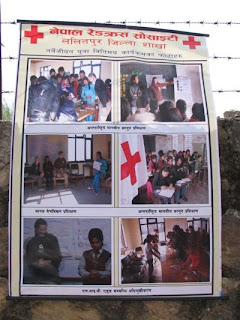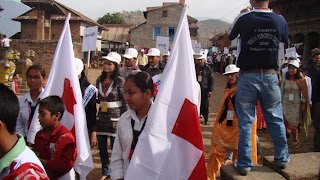

















 The place
The place
 The problem
The problem
 Most of the parents are not informed of the job status of their children.
Most of the parents are not informed of the job status of their children.
 other youths, to get inspiration and knowledge about the complexity of the problem and how they together can contribute in making a change for the people affected; their neighbors, friends and relatives.
other youths, to get inspiration and knowledge about the complexity of the problem and how they together can contribute in making a change for the people affected; their neighbors, friends and relatives.
 planned their coming work the coming year; peer education, door to door visits, orientations, discussions, street drama shows, folk song competition in their communities. I can nothing but wish them the best of luck in this very important Red Cross work - preventing human suffering!
planned their coming work the coming year; peer education, door to door visits, orientations, discussions, street drama shows, folk song competition in their communities. I can nothing but wish them the best of luck in this very important Red Cross work - preventing human suffering!

I needed my phone fixed, and suddenly my contact person and two volunteers are at my gate to help - one of them is the First Aid team leader in our district, and has the main coordinating responsibility for the Red Cross activities these bandh days. I invite for tea and we talk about the last five days.
- As a First Aid team leader and a focal person in Lalitupur DC I have experiences from before, says Maheshwori. In 2006 we also provided first aid. Then I was leader for one group only, now I am leader for the whole district. She is an efficient woman; member of executive committee, coordinator of Women development committee and First Aid Team coordinator. She continues: - According to the situation the first day, we mobilized six teams, including the logistic team. As the days have gone by, we have been scaling down the teams, one day at the time. Today we had only one mobile team in the streets. The last days we felt that we have too many volunteers in the streets. We don’t go to the places people sleep, we stay in the streets.
What do you do in the streets?
- We bandage wounds, sprains and strains. The wounds are caused by all the walking. They have also cramps in their feet, and for that we give them cream and massage. Some have stomach problems, we advise them to drink lot of water and distribute ORS (anti dehydration powder for mixing with water), Maheshwori explains. The strike is a peace full strike. We don't need so many volunteers in the streets.
I ask her how it is to be a Red Cross volunteer these days. She and my two other visitors laugh, take another sip of the tea and sit up straight. - As Red Cross personnel, we feel very proud to be out in the streets. People know us and they have a lot of respect for Red Cross. Whenever they need us, we are there, and this they know.
 So, what will the next day’s bring, you think?
So, what will the next day’s bring, you think?
- Tomorrow?! We will have to see the situation. Red Cross Action Team will be alert and first aid volunteers. They are informed and ready to join if needed within 15-20 min. We will always have one mobile team in the streets in Patan and the other five teams are on alert.
I want to say another thing, Maheshwori says, as the tea is finished, phone is fixed and the mosquitoes are getting more annoying: In 2006 we did not have a mobile team at our district. The volunteers had to walk for 5-6 hours every day and it was not always that they reached the places they were needed. Now we have a mobile team with a car and this is great progress. This means that we can reach the places we are needed in few minutes. We don’t have a Red Cross car, we are renting one. This also gives the volunteers a big relief, to know that they don't have to walk for a loooong time.


 our volunteers have been placed at four different posts and one as a mobile team. They are all in the streets to provide emergency services purely on humanitarian ground. So far they have been mostly occupied with distributing water purifying tablets and re-hydration solution to avoid dehydration.
our volunteers have been placed at four different posts and one as a mobile team. They are all in the streets to provide emergency services purely on humanitarian ground. So far they have been mostly occupied with distributing water purifying tablets and re-hydration solution to avoid dehydration.
Every 4 year there is an election at district level in Nepal, and lucky for us – this year was such a year. By lucky I mean that the opportunity to watch and be a part of such a process is both interesting and important to get a fully understanding of how our new national society works. Last weekend the district board was changed, and this is what happens:
To form a district chapter (in Nepal there are 75 districts, and each one of them has a district chapter) you have to have at least 10 sub chapters, consisting of at least 50 members. In Lalitpur District we have 15 active sub chapters and out of them, each sub chapter can send 5 representatives to vote at the district assembly, but for being sent out as a delegate from your sub chapter, you have to have been a Red Cross member for at least 5 years. These 5 people will choose the new District Executive Committee consisting of President + 12 members. This is not necessarily done by voting; this year 19 members from Sub Photo: Two delegates voting
Chapter level wanted to be members of District Chapter, but after negotiations and lobbying, one and one withdrew and they were left with a list of 12 persons that the Annual Meeting clapped on to show agreement and the new District Executive Committee was recognized. The same thing happened with the President election; two candidates, one withdrew and the new one was recognized.
Then the President chooses 5 extra persons from Sub Chapters that has not been elected into the Committee –  based on loyalty and trust, says Devi at my office. I have a hard time grasping the process, as it is so difficult from Norwegian Red Cross. Devi draws an organizational map and is very patient in his explanations on my sometimes very stupid questions. Then, he says, the President chooses who will be in positions as vice-president, treasurer, secretary etc. He also appoints leaders of all the sub committees in the district, based on their expertise (we have in our district these committees: woman development, community development, disaster management, Junior/Youth, health and ambulance and organizational development). In addition, the President appoints one person to sit in Ex.Com from the
based on loyalty and trust, says Devi at my office. I have a hard time grasping the process, as it is so difficult from Norwegian Red Cross. Devi draws an organizational map and is very patient in his explanations on my sometimes very stupid questions. Then, he says, the President chooses who will be in positions as vice-president, treasurer, secretary etc. He also appoints leaders of all the sub committees in the district, based on their expertise (we have in our district these committees: woman development, community development, disaster management, Junior/Youth, health and ambulance and organizational development). In addition, the President appoints one person to sit in Ex.Com from the
Photo: The District Executive Committee discussing
Government – to ensure a good cooperation and development of our Red Cross Chapter in Nepal.
 So, how can this affect our work, Emil and I ask each other. Well, on Friday last week we went to Banepa with 8 of our Youth leaders to learn from their experiences of having a Youth committee consisting of Youth for Youth. The newly elected President seams glad to support our work in developing such a structural change also in Lalitpur, and we will have closer talks on the subject on how this committee might be included in the District Chapter work on a day-to-day basis. The Youth themselves find this very important and is ready to fight for their rights to be heard when it comes to developing Red Cross as an organization in Nepal. We’re crossing our fingers for this to happen before we leave – only two months left now and there is still so much to do!
So, how can this affect our work, Emil and I ask each other. Well, on Friday last week we went to Banepa with 8 of our Youth leaders to learn from their experiences of having a Youth committee consisting of Youth for Youth. The newly elected President seams glad to support our work in developing such a structural change also in Lalitpur, and we will have closer talks on the subject on how this committee might be included in the District Chapter work on a day-to-day basis. The Youth themselves find this very important and is ready to fight for their rights to be heard when it comes to developing Red Cross as an organization in Nepal. We’re crossing our fingers for this to happen before we leave – only two months left now and there is still so much to do!
Next year will be election at national level; the campaigns for presidency will start soon and last for 14 months. This is something for the next years youth delegates to look forward to!
Photo: Youth Exchange project: We had our own poster printed :)





